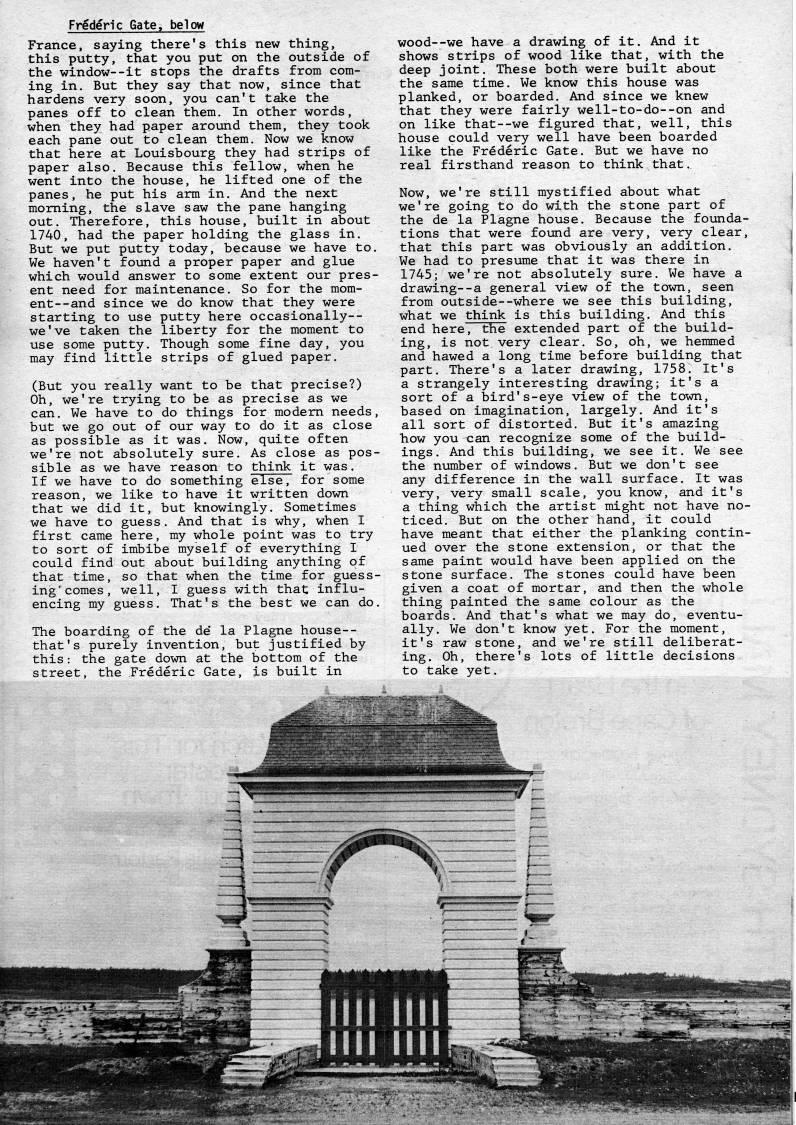Page 51 - Yvon LeBlanc, Architect Fortress of Louisbourg
Published by Ronald Caplan on 1983/8/1 (250 reads)
 Page 50 - Yvon LeBlanc, Architect Fortress of Louisbourg
Page 50 - Yvon LeBlanc, Architect Fortress of Louisbourg
Page 52 - Yvon LeBlanc, Architect Fortress of Louisbourg

Frederic Gate, below France, saying there's this new thing, this putty, that you put on the outside of the window--it stops the drafts from com? ing in. But they say that now, since that hardens very soon, you can't take the panes off to clean them. In other words, when they had paper around them, they took each pane out to clean them. Now we know that here at Louisbourg they had strips of paper also. Because this fellow, when he went into the house, he lifted one of the panes, he put his arm in. And the next morning, the slave saw the pane hanging out. Therefore, this house, built in about 1740, had the paper holding the glass in. But we put putty today, because we have to. We haven't found a proper paper and glue which would answer to some extent our pres? ent need for maintenance. So for the mxom- ent--and since we do know that they were starting to use putty here occasionally-- we've taken the liberty for the moment to use some putty. Though some fine day, you may find little strips of glued paper. (But you really want to be that precise?) Oh, we're trying to be as precise as we can. We have to do things for modem needs, but we go out of our way to do it as close as possible as it was. Now, quite often we're not absolutely sure. As close as pos? sible as we have reason to think it was. If we have to do something else, for some reason, we like to have it written down that we did it, but knowingly. Sometimes we have to guess. And that is why, when I first came here, my whole point was to try to sort of imbibe myself of everything I could find out about building anything of that time, so that when the time for guess? ing' comes, well, I guess with that influ? encing my guess. That's the best we can do. The boarding of the de' la Plagne house-- that's purely invention, but justified by this: the gate down at the bottom of the street, the Frederic Gate, is built in wood--we have a drawing of it. And it shows strips of wood like that, with the deep joint. These both were built about the same time. We know this house was planked, or boarded. And since we knew that they were fairly well-to-do--on and on like that--we figured that, well, this house could very well have been boarded like the Frederic Gate. But we have no real firsthand reason to think that. Now, we're still mystified about what we're going to do with the stone part of the de la Plagne house. Because the founda? tions that were found are very, very clear, that this part was obviously an addition. We had to presume that it was there in 1745; we're not absolutely sure. We have a drawing--a general view of the town, seen from outside--where we see this building, what we think is this building. And this end here, the extended part of the build? ing, is not very clear. So, oh, we hemmed and hawed a long time before building that part. There's a later drawing, 1758. It's a strangely interesting drawing; it's a sort of a bird's-eye view of the town, based on imagination, largely. And it's all sort of distorted. But it's amazing how you can recognize some of the build? ings. And this building, we see it. We see the number of windows. But we don't see any difference in the wall surface. It was very, very small scale, you know, and it's a thing which the artist might not have no? ticed. But on the other hand, it could have meant that either the planking contin? ued over the stone extension, or that the same paint would have been applied on the stone surface. The stones could have been given a coat of mortar, and then the whole thing painted the same colour as the boards. And that's what we may do, eventu? ally. We don't know yet. For the moment, it's raw stone, and we're still deliberat? ing. Oh, there's lots of little decisions to take yet.
 Page 50 - Yvon LeBlanc, Architect Fortress of Louisbourg
Page 50 - Yvon LeBlanc, Architect Fortress of Louisbourg
Page 52 - Yvon LeBlanc, Architect Fortress of Louisbourg

Adobe Acrobat Reader is required to the PDF version of this content. Click here to download and install the Acrobat plugin



